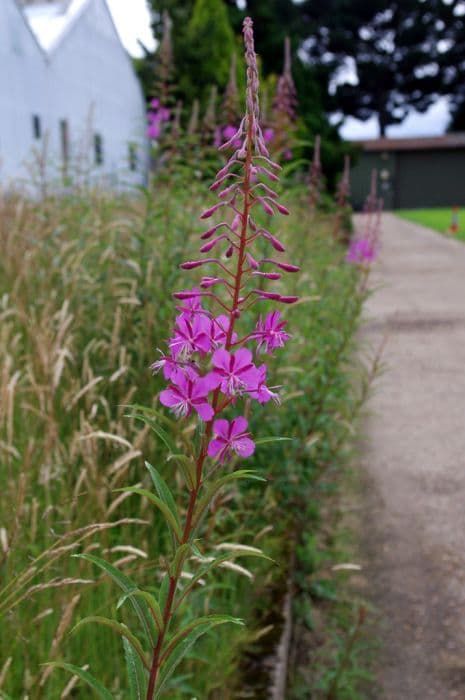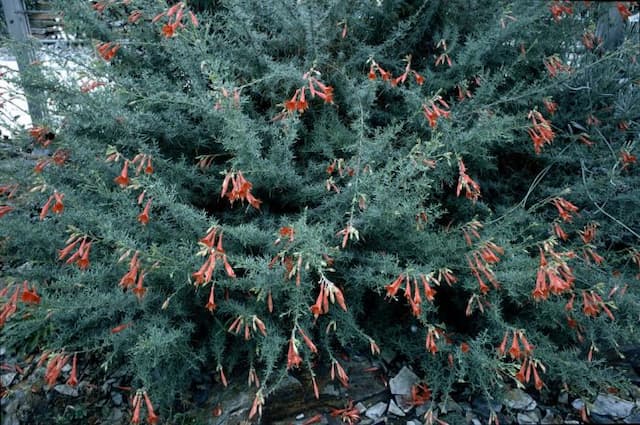Fuchsia Fuchsia 'Heidi Ann' (d)

ABOUT
Fuchsia 'Heidi Ann' is a delightful ornamental plant that captures attention with its striking flowers and foliage. The blossoms of this Fuchsia are particularly striking, often appearing in a beautiful display of fusion between pink and purple. The flowers feature a charming pendulous shape, resembling elongated teardrops or small lanterns. They are composed of a tube-like structure with flared sepals at the base that typically contrast in color to the inner, skirt-like petals which often exhibit a brighter or deeper hue. These exquisite flowers dangle gracefully from arching stems, creating a delightful visual display. Surrounding the flowers, the foliage of the Fuchsia 'Heidi Ann' adds to its ornamental value. The leaves are generally rich green, with a lush and slightly glossy appearance that complements the overall aesthetic. The leaves can either be simple or have a subtle serration along the edges, adding texture to the appearance of the plant. The growth habit of the Fuchsia 'Heidi Ann' tends to be bushy and spreading, with the branches creating an open and airy structure that showcases its floral beauty. The contrast between the vibrant blooms and the verdant leaves makes this plant a popular choice for adding a splash of color to gardens, hanging baskets, and container displays. Its alluring charm is further enhanced when it sways gently in a light breeze, making it a captivating sight in any planting arrangement.
About this plant
 Names
NamesFamily
Onagraceae
Synonyms
Heidi Ann Fuchsia, Lady's Eardrops
Common names
Fuchsia 'Heidi Ann'
 Toxicity
ToxicityTo humans
Fuchsia 'Heidi Ann', commonly known as Fuchsia, is not known to be toxic to humans. Generally, Fuchsias are considered non-toxic and safe if accidentally ingested in small quantities. There are no significant toxic effects or symptoms of poisoning associated with ingesting parts of the Fuchsia plant. However, it is always advisable to exercise caution and avoid eating ornamental plants.
To pets
Fuchsia 'Heidi Ann', commonly referred to as Fuchsia, is not considered toxic to pets. This species of Fuchsia is typically safe for both dogs and cats if ingested in small amounts. There are no known toxic properties that cause symptoms of poisoning in pets from the ingestion of Fuchsia plants. Nonetheless, it's recommended to prevent pets from consuming plants, as ingestion might lead to gastrointestinal upset out of individual sensitivity or because of pesticides or other chemicals on the plants.
 Characteristics
CharacteristicsLife cycle
Perennials
Foliage type
Deciduous
Color of leaves
Green
Flower color
Mixed
Height
1-2 feet (30-60 cm)
Spread
1-2 feet (30-60 cm)
Plant type
Shrub
Hardiness zones
9
Native area
Central and South America
Benefits
 General Benefits
General Benefits- Attractive Flowers: Fuchsia 'Heidi Ann' produces beautiful, pendant-like flowers that can enhance the visual appeal of any garden or balcony.
- Versatile Plant: Suitable for planting in hanging baskets, containers, and borders, offering flexibility in garden design.
- Long Flowering Period: It has a lengthy blooming season, providing color from late spring to early fall.
- Attracts Pollinators: Flowers attract hummingbirds and butterflies, aiding in the pollination of your garden.
- Shade Tolerance: Can thrive in partial shade, which is beneficial for gardens with limited direct sunlight.
- Relatively Easy Care: While it requires regular watering and fertilization, it's considered to be low-maintenance in comparison to other flowering plants.
 Medical Properties
Medical PropertiesThis plant is not used for medical purposes.
 Air-purifying Qualities
Air-purifying QualitiesThis plant is not specifically known for air purifying qualities.
 Other Uses
Other Uses- Butterfly and Hummingbird Attraction: Fuchsia plants, including 'Heidi Ann', are known to attract butterflies and hummingbirds due to their brightly colored flowers, adding beauty and activity to the garden.
- Photography Subject: The intricate and vibrant flowers of the Fuchsia make it a popular subject for photographers and artists looking to capture the beauty of nature.
- Living Wreaths: The flexibility of Fuchsia stems allows for the creation of living wreaths, providing a unique and organic decorative element.
- Teaching Tool: Fuchsia can be used in educational settings to teach students about plant anatomy, pollination, and the care of flowering plants.
- Container Gardening: Because of their suitable size and cascading habit, Fuchsia, 'Heidi Ann' can be used in container gardens to add a splash of color to balconies, patios, and decks.
- Hanging Basket Displays: This plant variety is perfect for hanging baskets, allowing its drooping flowers to be displayed at eye level for a stunning visual impact.
- Fairy Gardens: Due to their small size and delicate flowers, Fuchsias are often used to create whimsical fairy gardens, especially appealing to children and fantasy enthusiasts.
- Floral Arrangements: The vivid blooms of Fuchsia can be used in cut floral arrangements to provide a striking contrast against green foliage.
- Ink Dye: The bright pigments of the Fuchsia flowers may be used in the creation of natural dyes for inks and fabrics, though it's not a common practice.
- Craft Projects: Dried Fuchsia flowers can be incorporated into various craft projects, including pressed flower art, bookmarks, or potpourri.
Interesting Facts
 Feng Shui
Feng ShuiThe Fuchsia is not used in Feng Shui practice.
 Zodiac Sign Compitability
Zodiac Sign CompitabilityThe Fuchsia is not used in astrology practice.
 Plant Symbolism
Plant Symbolism- Confidence - The vibrant colors of the Fuchsia flower represent boldness and beauty, often inspiring a sense of confidence in the beholder.
- Elegance - With its graceful drooping flowers, the Fuchsia 'Heidi Ann' symbolizes elegance and poise.
- Good Taste - Known for its ornamental beauty, the Fuchsia represents having good taste and appreciation for aesthetic qualities.
- Amiability - The delicate appearance and engaging colors of the Fuchsia flower make it a symbol of amiability and warmth in relationships.
 Water
WaterLady's Eardrops should be watered deeply, allowing the water to saturate the soil until it runs out of the bottom of the pot, ensuring the roots get enough moisture. They prefer evenly moist soil, so water them when the top inch of soil feels dry to the touch. This could be roughly every 2-3 days during their active growth period in spring and summer, depending on the environment. Reduce watering in the fall and winter when the plant is not actively growing. Generally, expect to give these plants about 16-24 ounces of water per week during the growing season.
 Light
LightLady's Eardrops thrive in bright, indirect light. They perform best when placed in a location that receives morning sunlight and afternoon shade, as hot afternoon sun can scorch the delicate leaves. A north-facing or east-facing window is ideal for providing the right balance of light throughout the day.
 Temperature
TemperatureLady's Eardrops prefer a cool to moderate climate, with ideal daytime temperatures ranging between 60 to 70 degrees Fahrenheit and nighttime temperatures a bit lower, around 55 to 65 degrees Fahrenheit. They can tolerate a minimum of 40 degrees Fahrenheit and a maximum of 80 degrees Fahrenheit. Avoid locations with drastic temperature changes or direct heat sources.
 Pruning
PruningLady's Eardrops benefit from regular pruning to encourage bushier growth and more blooms. Prune back the tips of the branches in the spring, before the start of the growth season, to promote branching. Deadhead flowers regularly to prolong the blooming period. Pruning can be done every few weeks during the growing season to maintain shape and encourage flowering.
 Cleaning
CleaningAs needed
 Soil
SoilFuchsia 'Heidi Ann' thrives best in a well-draining soil mix that's rich in organic matter. A mix of 2 parts peat moss, 1 part perlite, and 1 part loamy soil is ideal. Maintain a soil pH between 6.0 and 7.0 for optimal growth.
 Repotting
RepottingFuchsia 'Heidi Ann' should be repotted every two to three years, or when it becomes root-bound. Early spring, before the onset of new growth, is the best time for repotting.
 Humidity & Misting
Humidity & MistingFuchsia 'Heidi Ann' prefers high humidity levels, typically between 60-70%. Avoid environments that are too dry, as they can lead to stress and poor plant health.
 Suitable locations
Suitable locationsIndoor
Place Fuchsia 'Heidi Ann' in bright, indirect light and ensure high humidity.
Outdoor
Keep Fuchsia 'Heidi Ann' in partial shade and sheltered from wind.
Hardiness zone
10-11 USDA
 Life cycle
Life cycleFuchsia 'Heidi Ann' begins its life as a seed, which when sown in fertile, well-drained soil and provided with adequate warmth and moisture, germinates to produce a small seedling. The seedling stage is followed by vegetative growth, where it develops a robust root system and foliage through the process of photosynthesis. Once mature, the fuchsia plant enters the flowering stage, producing distinctive pendulous flowers that are a combination of purple and pink hues, attracting pollinators such as hummingbirds and bees. After pollination, the flowers develop into small, dark-colored fruits which contain seeds for the next generation. In seasonal climates, Fuchsia 'Heidi Ann' may enter a period of dormancy during cold weather, losing leaves and appearing inactive, only to regrow leaves and resume active growth and flowering with the return of favorable conditions. In non-seasonal, warmer climates, it may grow and flower continuously throughout the year.
 Propogation
PropogationPropogation time
Spring-Early Summer
Propogation: Fuchsia 'Heidi Ann', commonly known simply as Fuchsia, is best propagated during late winter or early spring, prior to the onset of new growth. The most popular method is by taking stem cuttings, which involves selecting healthy, non-flowering shoots about 2 to 4 inches (5 to 10 centimeters) long. Each cutting should have at least two sets of leaves and the cut should be made just below a leaf joint. The bottom leaves are removed and the stem base is dipped in rooting hormone to accelerate root growth. The prepared cuttings are then inserted into a mixture of moistened peat and perlite or multipurpose compost, ensuring that the leaf nodes where the leaves were removed are below the surface. The pot is covered with a plastic bag or placed in a propagator to maintain high humidity, and kept in a bright spot out of direct sunlight until new growth indicates that rooting has occurred.









